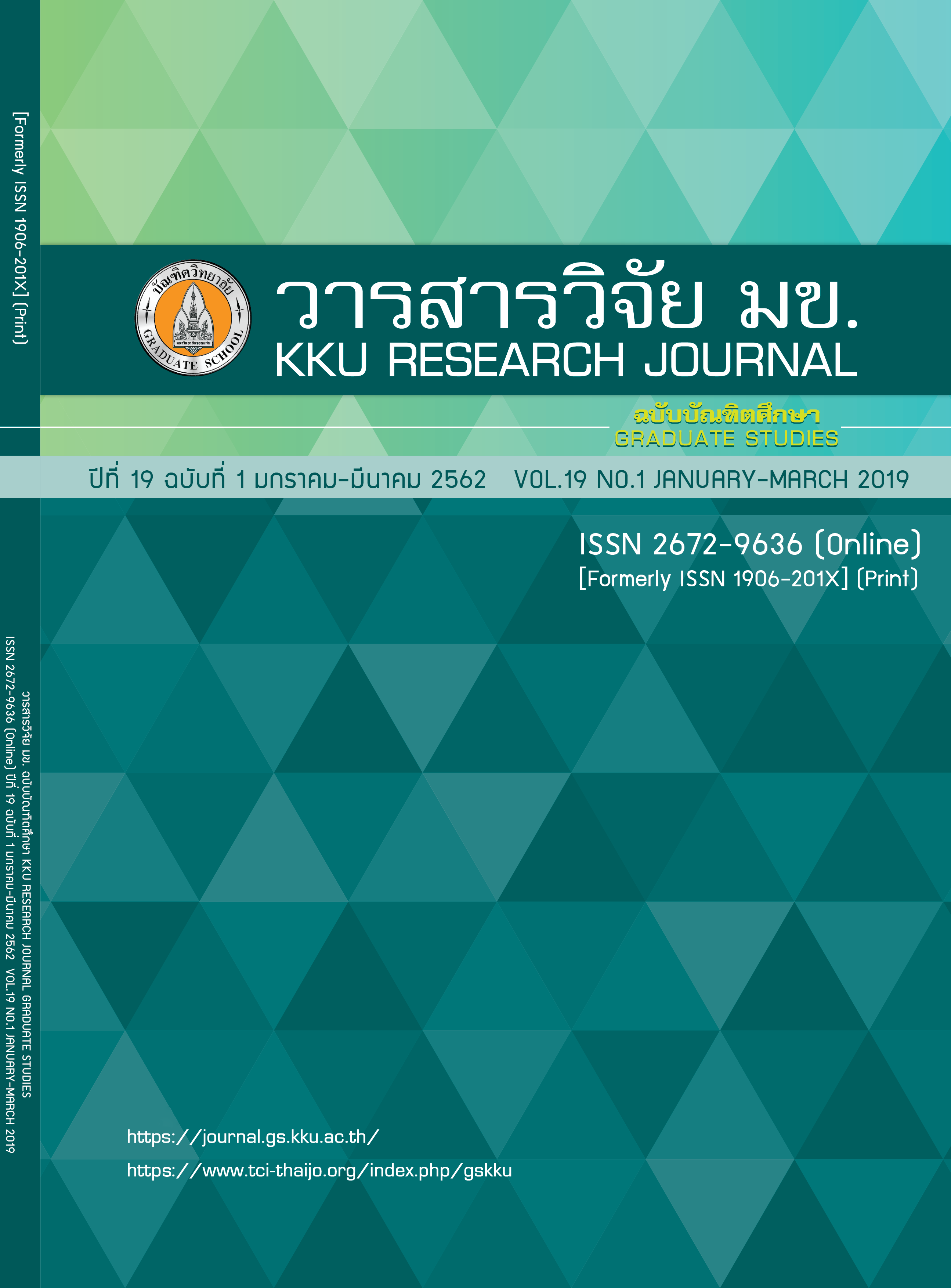Charcoal-Polyurethane Composite Material for Insulation
Keywords:
Black liquor, Lignin, Polyurethane, Composite materialAbstract
This research was to optimized preparation conditions of charcoal-polyurethane composite material for using as an insulator. Charcoal was prepared from lignin which is a major component of black liquor. The composition of lignin was analyzed by CHNS/O analyzer, and found that it was composed of Carbon Nitrogen and Oxygen by 60.93, 5.60, and 0.20% respectively. The charcoal was prepared by carbonized lignin at 385 oC for 1 hr at heating rate 10 oC/min and was applied as the reinforced in polyurethane composite. The compressive stress of the charcoal-polyurethane composite material was found between 0.186-0.645 MPa, and thermal conductivity decreased from 0.466 to 0.149 W/m.K with respect to the increment of the percentage of charcoal from 0 to 20 wt%. The lowest thermal conductivity is 0.149 W/m.K at 20 wt% charcoal. Thermal stability of the material was tested by thermal cycling method at 5-80 oC, 500 cycles. The result shows that there is no deterioration and alteration of charcoal-polyurethane composite material. The thermal stability was confirmed by FT-IR and DSC result at pre- and post-thermal cycling testing, the heat capacity were 37.50 and 36.63J/g, respectively which the difference is not significant.
References
2. Chalit A. Polyurethane product quality improvements by using reaction-injection-molding flow analysis [Master Thesis in Mechanical Engineering]. Bangkok: The Graduate School, Kasetsart University; 2006. Thai.
3. Prattana T. Operation strategies for maximizing electrical output of cogeneration system in a pulp mill [Master Thesis of Engineering in Energy Management Technology]. Bangkok: The Graduate School, King Mongkut’s University of Technology Thonburi; 2012. Thai.
4. Office of Industrial Economics. Index Industrial [Online] 2013 [Cited 29 Nov 2014]. Available from: http://
www.oie.go.th/academic/statistics
5. ASTM International. ASTM D1621 - 00 Standard Test Method for Compressive Properties Of Rigid Cellular Plastics [Online] 2014 [Cited 25 Jul 2017]. Available from: https://www.astm.org/DATABASE.
CART/HISTORICAL/D1621-00.htm
6. Zhang C, Wu H, Kessler MR. High bio-content polyurethane composites with urethane modified lignin as filler. Polymer 2015; 69: 52–57.
7. Sameni J, Krigstin S, Sain M. Characterization of lignins isolated from industrial residues and their beneficial uses. BioResources 2016; 11: 8435–8456.
8. Lazzarini A. Activated carbons for applications in catalysis: the point of view of a physical-chemist.
Rendiconti Lincei 2017; 1: 1–14.
9. Dhevi DM, Prabu AA, Kim KJ. Hyperbranched polyester as a crosslinker in polyurethane formation: real-time monitoring using in situ FTIR. Polymer Bulletin 2016; 73: 2867–2888.
10. Ciecierska E, Jurczyk-Kowalska M, Bazarnik P, Kowalski M, Krauze S, Lewandowska M. The influence of carbon fillers on the thermal properties of polyurethane foam. Journal of Thermal Analysis and Calorimetry 2016; 123: 283–291.
11. Karaipekli A, Biçer A, Sarı A, Tyagi VV. Thermal characteristics of expanded perlite/paraffin composite phase change material with enhanced thermal conductivity using carbon nanotubes. Energy Conversion and Management 2017; 134: 373–381.
12. Lorwanishpaisarn N, Kasemsiri P, Posi P, Chindaprasirt P. Characterization of paraffin/ultrasonic-treated diatomite for use as phase change material in thermal energy storage of buildings. Journal of Thermal Analysis and Calorimetry 2017; 128: 1293–1303.
13. Hoseinabadi M, Naderi M, Najafi M, Motahari S, Shokri M. A study of rigid polyurethane foams: The effect of synthesized polyols and nanoporous graphene. Journal of Applied Polymer Science 2017; 134: 1–6.



